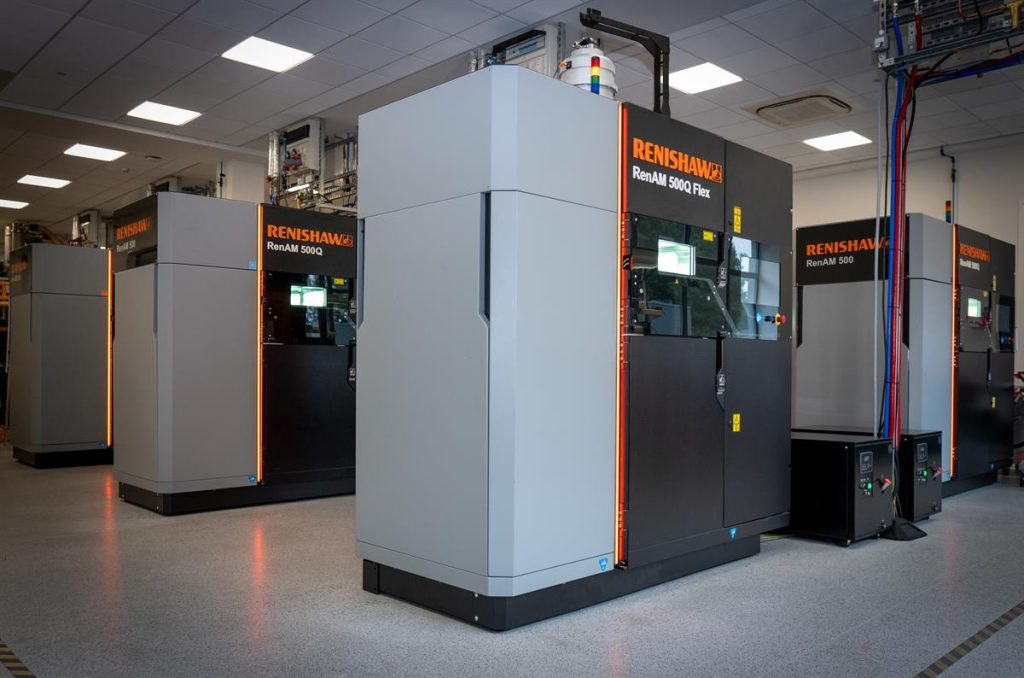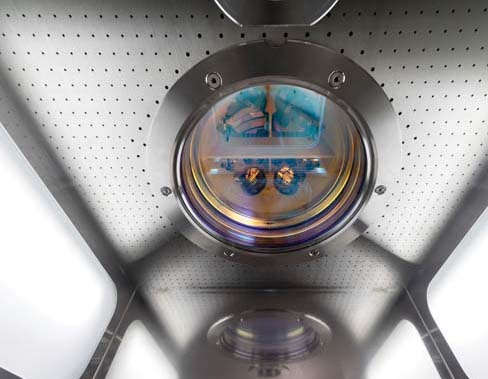UK-based engineering firm Renishaw (RSW) has launched two new versions of its RenAM 500 3D printer with upgraded powder handling capabilities at the Formnext trade show.
Unveiled at Renishaw’s booth, the enhanced RenAM 500S and 500Q Flex machines feature simplified powder handling systems, which enable users to more easily change materials without hindering part quality. The systems also make scaling effortless for users, as their parameters don’t need re-qualification prior to entering mass-production, making them ideal for R&D or service bureau manufacturers.
“Once the pre-production stage is complete, the common build environment allows any parameters to be directly transferred to a RenAM 500Q with powder recirculation, without the need to retest the gas flow, chamber and optics,” explained Lily Dixon, AM Project Manager at Renishaw. “Manufacturers can also build full-size parts on a small scale before mass-production.”
“Manufacturers can quickly change powders in the RenAM 500S Flex and RenAM 500Q Flex in-house, giving them the flexibility they need to meet customer demand.”

Renishaw’s metal AM expertise
Based in the UK, Renishaw has a vested interest in various engineering-related technologies including spectroscopy, precision measurement and metal machining. The firm has also built up a strong metal 3D printing offering, comprising its RenAM 500 machines, softwares, ancillaries and an array of end-use-qualified materials, such as titanium, aluminum, cobalt chromium, steel and nickel alloys.
In an attempt to find new applications for these technologies, Renishaw has established several industry partnerships over the last 18 months, spanning the medical, aerospace and sports gear industries. Working alongside Herantis Pharma, for instance, the company has been able to create and test a unique ‘neuroinfuse drug delivery device,’ with the potential to treat illnesses like Parkinson’s disease.
As part of an Aerospace Technology Institute project, Renishaw has also begun developing a mass-production aerospace 3D printer capable of creating aircraft components at scale, while a collaboration with British Cycling last year saw the firm deploy the original 500Q to help build Team GB’s Tokyo 2020 track bike.
On the business front, Renishaw’s ‘Fit for the Future’ campaign has curtailed its 3D printing sales somewhat but protected it from the worst of the pandemic, and it reported a FY 2021 pre-tax profit of £120 million. The company also achieved this feat in spite of attempts by its majority shareholders to sell their stake earlier this year, but having failed to find a buyer, both are now committed for the long haul.

Flexing-up with the new RenAM
Much like the rest of the RenAM 500 range, the Flex includes a 250mm x 250mm x 350mm build volume, intelligent high-volume gas flow system and intercooler integrated gas circuit. The machines are therefore capable of creating uniform conditions for processing parts with a consistent metallurgy, while their ‘SafeChange’ filter systems ensure that such builds aren’t disrupted mid-print.
Thanks to these features, Ren AM 500 systems old and new are said to yield components that are free of any chemical, micro-structure or mechanical defects with a density of up to 99.9%, as well as ‘maximized strength and ductility.’
Where the new single-laser 500S and quad-laser 500Q differ from their predecessors, is that they provide users with greater flexibility when changing powder, allowing bureau adopters to more easily meet client demand. In practise, the machines are able to achieve this via their new closed loop powder recirculation and open gravity fed systems, which reduce the need for user intervention, and effectively maximize throughput.
“If the manufacturer no longer requires a flexible AM system, the Flex can be converted into a recirculating machine — a feature that is unique to this system,” explained Dixon. “Converting the system provides manufacturers with the highest productivity additive manufacturing option for serial production.”
As an added benefit, the RenAM 500S and 500Q are able to switch between these modes in-situ, enabling a seamless transition between R&D and production while powder is recirculating. In doing so, Renishaw says that “each stage of lab-to-volume production can be performed on a single machine” and upgraded as users’ applications require, ensuring a “seamless transition to volume manufacturing.”

Renishaw’s LPBF competitors
As impressive as Renishaw’s latest powder recirculation system-equipped machines are, they are designed to address an increasingly competitive laser powder bed fusion market. One such competitor is EOS, a company whose 3D printers continue to find aerospace applications, and its P396 machine, is currently being used by Etihad Engineering to explore the serial production of aircraft parts.
SLM Solutions has also worked with aviation specialist Safran Landing Systems recently to 3D print business jet landing gear at a previously-unprecedented scale. Through adopting the SLM 800, Safran was able to expedite the part’s qualification and identify its optimal design within days, before creating a 15% lighter component than conventional alternatives.
Similarly to Renishaw, TRUMPF manufactures plenty of machinery that’s unrelated to 3D printing, but its ‘Laser Metal Fusion’ offering has found extensive aerospace and automotive applications. In one such use-case, the firm worked with MAHLE in July 2020 to 3D print Porsche 911 pistons with a newly-integrated design, that provided the car’s engine with 30 extra horsepower.
To stay up to date with the latest 3D printing news, don’t forget to subscribe to the 3D Printing Industry newsletter or follow us on Twitter or liking our page on Facebook.
For a deeper dive into additive manufacturing, you can now subscribe to our Youtube channel, featuring discussion, debriefs, and shots of 3D printing in-action.
Are you looking for a job in the additive manufacturing industry? Visit 3D Printing Jobs for a selection of roles in the industry.
Featured image shows a row of Renishaw’s new 500Q Flex 3D printers. Photo via Renishaw.


